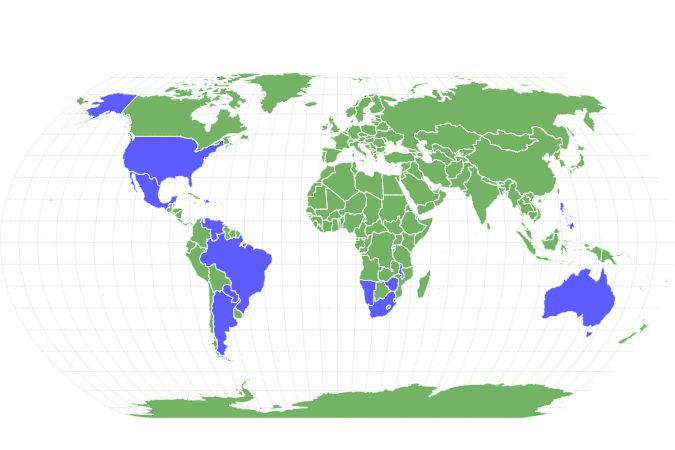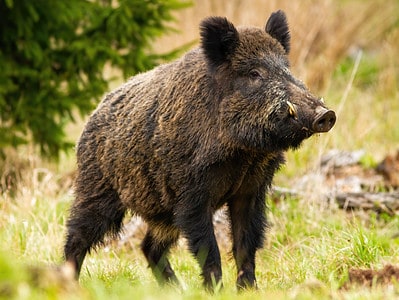Senepol Cattle
Bos taurus
Senepol cattle have a distinctive red color and no horns.
Advertisement
Senepol Cattle Scientific Classification
- Kingdom
- Animalia
- Phylum
- Chordata
- Class
- Mammalia
- Order
- Artiodactyla
- Family
- Bovidae
- Genus
- Bos
- Scientific Name
- Bos taurus
Read our Complete Guide to Classification of Animals.
Senepol Cattle Conservation Status
Senepol Cattle Facts
- Name Of Young
- Calf
- Group Behavior
- Herd
- Herds
- Fun Fact
- Senepol cattle have a distinctive red color and no horns.
- Most Distinctive Feature
- Red coat
- Distinctive Feature
- Polled
- Temperament
- Good-natured, docile
Senepol Cattle Physical Characteristics
- Color
- Brown
- Red
- Black
- Skin Type
- Skin
- Lifespan
- 15 to 20 years
- Weight
- 1200 for cows, 2000 for bulls on average
- Age of Sexual Maturity
- Two years
- Age of Weaning
- Seven months on average
- Venomous
- No
- Aggression
- Low
View all of the Senepol Cattle images!
Senepol cattle are a specially created breed from St. Croix, one of the U.S. Virgin Islands. Breeders created them by selectively breeding N’Dama cattle from Senegal and the British red poll cattle from the island. It is no difficult task identifying these animals. Their unique red color and lack of horns, among many other desirable, qualities. Breeders rear Senepol cattle for their top-notch milk and meat production. They happen to be one of the most sought-after cattle breeds.
Facts
- Two of the most striking features of the Senepol cattle breed are their red color and their lack of horns. They are a naturally polled breed. This means they do not have horns.
- Senepol cattle have a short, fine coat, which makes it impossible for insects such as ticks to latch onto them. This makes them resistant to insects and insect-borne diseases. They are even resistant to trypanosomiasis (sleeping sickness), which the Tsetse fly transmits.
- Senepol cattle are very tolerant of heat and can withstand difficult climate conditions where other breeds have failed. They have large, baggy sweat glands which help keep them cool by regulating their internal body temperatures during grazing. This enables them to stay out feeding for over an hour longer than other breeds.
- Senepol cattle are acclaimed for their tender beef and high milk production. Due to this, they are highly sought-after for cross-breeding purposes to improve the meat and milk yield of other breeds of cattle.
- Senepol cattle can thrive with poor quality of forage without diminishing their beef quality and weight. Their hybrid Red Poll and N’Dama nature is responsible for the hardiness of this breed.
- Senepol cows possess great mothering abilities and take excellent care of their offspring, weaning them up to half of their own weight.
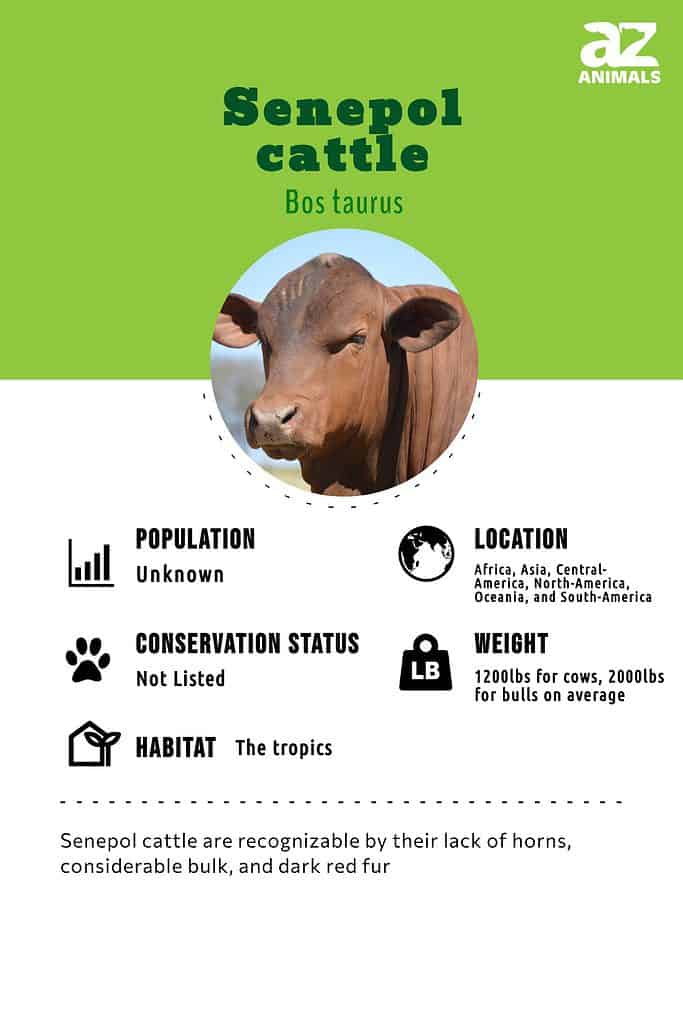
Evolution and Origins
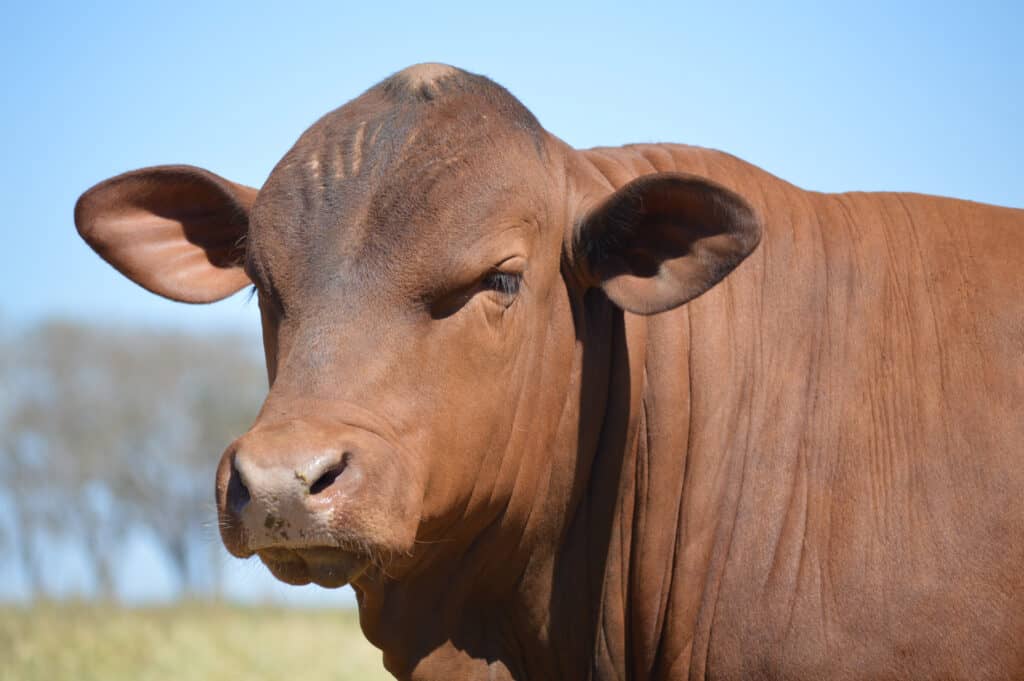
Senepol cattle were bred in St. Croix
©Diego Franco Miguel/Shutterstock.com
The name “Senepol” is a nod to the Senepol’s origins. It is a cross between the names “Senegal” and “red poll.”
Although the Senepol cattle breed originated from the N’Dama breed from the West African country of Senegal, it is now contains admixture from Zebu cattle, too. Because of the breed’s adaptation to the Senegalese environment, there was hope that the N’Dama cattle would survive and thrive in spite of the harsh climate of St. Croix. And so, in the 1800s, they were imported to St. Croix. Breeders eventually cross-bred them with the red poll cattle in order to develop superior traits that would be necessary to elevate the breed’s pre-existing traits.
The British red poll cattle breed brought several desirable genes to the N’Dama: high milk production and fertility, and natural polling. As time went on, breeders heightened selection to ensure that they only bred the best cattle with the most favorable expressions of these traits. The full-blooded Senepol cattle then came to be.
Senepol cattle belong to the order Artiodactyla. Animals of that order are animals with hooves that bear equal weight on two of their five toes. As part of the family Bovidae, Senepol cattle are ruminant animals with cloven hoofs. Bovidae comprises of 52 genuses and 146 extant species, including the goat, antelope, bison, wildebeest, and sheep. The scientific name for Senepol cattle is Bos taurus. The British Red Poll and the N’Dama are Bos taurus breeds while the Zebu is Bos taurus indicus.
Other animals that belong to the family Artiodactyla include camels, buffalos, and giraffes.
Physical Appearance
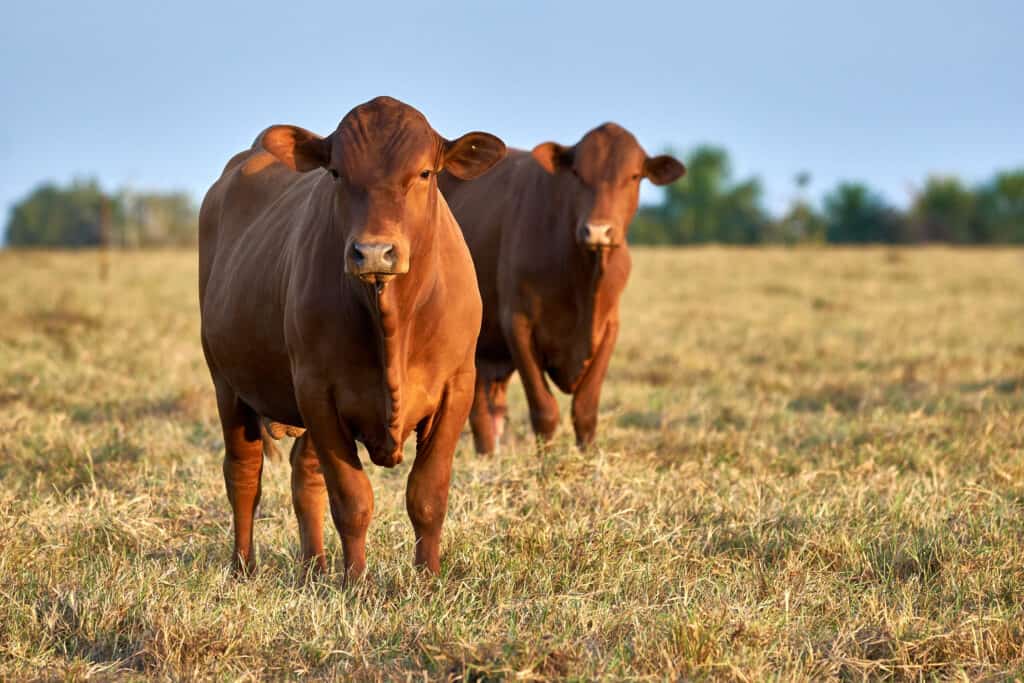
Senepol cattle are known for their distinctive color and lack of horns.
©BENJAMIN MEDINA/Shutterstock.com
Senepol cattle are medium-sized cattle, renowned for their distinctive deep red color, although some of them can be black or brown as well. They have short hair and are naturally polled, which means that they do not have horns. This is a favorable characteristic because it reduces the risk of injury between animals in feedlots and eases transportation as well. Their characteristic red color, polled nature, and high milk production is courtesy of its Red Poll ancestry. This breed is gentle and docile.
Due to their N’Dama breed origins in West Africa and Zebu influence, Senepol cattle have an incredible tolerance for heat. They are able to regulate their internal body temperatures through their baggy sweat glands to keep cooler than other breeds, and this allows them to graze longer, too.
Senepol bulls are significantly larger in size than the cows. Adult Senepol heifers have an average weight of 1,000 to 1,200 pounds, while the bulls average 1,760 to 2,100 pounds at pasture. The cows are very maternal and calve with ease. They yield a large quantity of milk and wean their calves in five to seven months at half of their own weight.
Senepol cattle are a disease and insect-resistant breed. Studies show that they possess higher immunity than other breeds, all thanks to their N’Dama origins and breeding selections. Their short, fine hair makes it hard for insects such as ticks to latch onto. This makes them less prone to insect-borne diseases, especially those of parasitic origin. They are highly resistant to trypanosomiasis, or sleeping sickness, which is borne by the Tsetse fly.
Senepol cattle are also known for their quality meat and high milk production. Their beef is critically acclaimed and known to be tender and delicious.
Habitat and Population
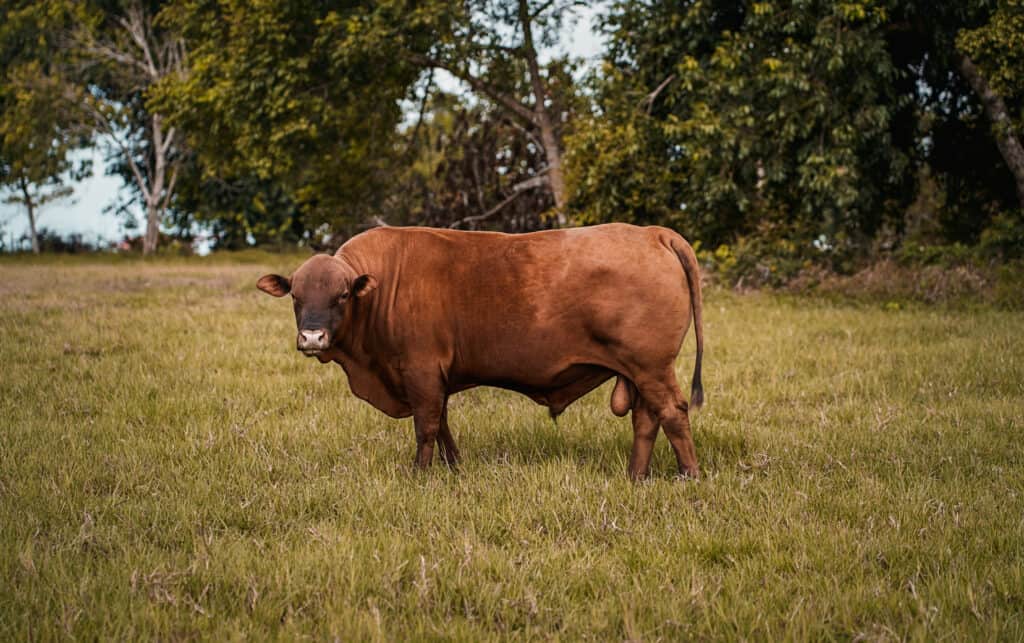
Senepol cattle are in high demand owing to their ability to withstand dry hot climates and tropical, humid weather
©BENJAMIN MEDINA/Shutterstock.com
Senepol cattle are a highly sought-after breed due to their adaptability to high temperatures, good meat and milk production, docile nature, and other desirable characteristics.
Having originated in the West African terrain as well as the harsh environment of the U.S. Virgin Islands, Senepol cattle have thoroughly adapted to tropical climates where other breeds have failed. This breed thrives in wet tropics with high humidity and rainfall, and hot dry savanna country.
Four main herds exist on the St. Croix island to date. The largest herd is home to 400 cows and the second largest is home to 200.
Over 500 breeders and over 14,000 cattle are registered with the Senepol Cattle Breeders Association. Senepol cattle have become widespread with presence in many countries including the United States, Venezuela, Brazil, Zimbabwe, Philippines, Mexico, South Africa, Namibia, and Paraguay.
A lot of Senepol cross-breeds can also be found in various parts of the world as a result of breeders wanting to incorporate the breed’s superior characteristics into other breeds. Some of these include Brahman, Hereford, and Angus crossbreeds.
The Senepol cattle breed is not currently listed on the IUCN Red List of endangered species.
Diet
Senepol cattle are mostly fed grass. They love to graze, but they can also be fed in feedlots. They can rely on poor quality food without reducing the quality of their beef and milk yield.
Senepol cattle are ruminant animals, which means that their stomach has four chambers. Digestion begins in the mouth. When the food moves into the first stomach, or rumen, it turns into cud. It is then regurgitated and chewed again. This process is called “chewing the cud”.
Due to their high adaptability to heat, Senepol cattle can graze for over an hour longer in the sun than most other breeds.
Reproduction and Lifespan

Senepol cattle are prolific breeders
©leogiraldo29/Shutterstock.com
Senepol cattle have an enviable reproductive life, excellent fertility, and many other favorable traits. They have a lifespan of about 15 to 20 years.
Senepol bulls have high libidos and are tenacious breeders. They produce highly efficient sperm within 12 to 14 months of age. Senepol heifers have straight cervices which aids birthing. In addition to being exceptional mothers, Senepol cows are highly efficient when it comes to calving. They give birth quickly, reducing the risk of calf injury and oxygen restriction. The calves come out strong and ready to go!
Senepol cows reach puberty earlier than Bos indicus cattle breeds and, under optimum management, calve at just two years of age. Because of their physical characteristics, they birth easily and their calves have a lot of vigor. They typically do not need a human’s helping hand to stand up after they are born. They tend to manage well on their own.
The heifers wean the calves up to 40 to 50% of their own body weight of 1,000 to 1,200 pounds. This is an outstanding feat, especially considering that Senepol calves usually reach weaning age at five to seven months and only weigh about 75 pounds at birth. This attests to the fact that Senepol cows are very diligent mothers when it comes to feeding their offspring and that they have a high milk yield. They are prolific mothers, calving at optimal intervals, and they can reproduce for up to 15 to 20 years.
Many cattle breeders refer to the Senepol breed as the universal cross-breeding animal. One of the biggest benefits to crossbreeding Senepol cattle is that they possess favorable dominant traits, such as its lack of horns. Offspring are more likely to manifest such traits. As much as 80% to 100% of cross-bred animals show Senepol traits.
Predators and Threats
Humans have domesticated Senepol cattle. Because of that, human beings are in charge of their welfare and protection. As human beings make a living off of the beef and milk production of these animals, they are generally well-protected and cared for. However, with grazing cattle, there is always the possibility that a predator, such as the wolf, coyote, or cougar, could target young calves, old or injured animals, or animals that veer away from the main herd. Mother Senepols do a great job of fending off predators from their young. Owners and breeders typically keep their Senepols well-guarded, since they do not have horns to defend themselves with.
Related Animals…
View all 293 animals that start with SSenepol Cattle FAQs (Frequently Asked Questions)
Why are Senepol cattle red?
Senepol cattle are red because they were originally bred with British red poll cattle, which gave them their red color.
Where are Senepol cattle originally from?
Senepol cattle are mostly a hybrid breed created from the N’Dama cattle from Senegal, West Africa, and the British red poll cattle breeds.
Is Senepol a good cattle breed?
Senepol is a very good-natured breed and the meat and milk yield and quality are very high. They are a sought-after breed for their adaptive traits and physical characteristics.
Do Senepol cattle have horns?
Senepol cattle are a naturally polled breed, which means they are hornless.
Are all Senepol cattle red?
No, Senepol cattle come in three main colors – red, black, or brown. However, most of them are red in color.
What kind of climate suits Senepol cattle the most?
Senepol cattle are well-adapted to hot weather. They prefer the humid tropics or hot and dry climates.
Thank you for reading! Have some feedback for us? Contact the AZ Animals editorial team.
Sources
- Australian Senepol Breeders Association, Available here: https://www.senepol.com.au/breed#history
- Cattle International Series, Available here: https://cattleinternationalseries.weebly.com/senepol.html
- Senepol Cattle Breeders Society of South Africa, Available here: https://www.senepolsa.co.za/Breed-History.htm
- The Cattle Site, Available here: https://www.thecattlesite.com/breeds/beef/81/senepol
- Wikipedia, Available here: https://en.wikipedia.org/wiki/Senepol
- Oklahoma State University Department of Animal Science, Available here: http://afs.okstate.edu/breeds/cattle/senepol/index.html/

